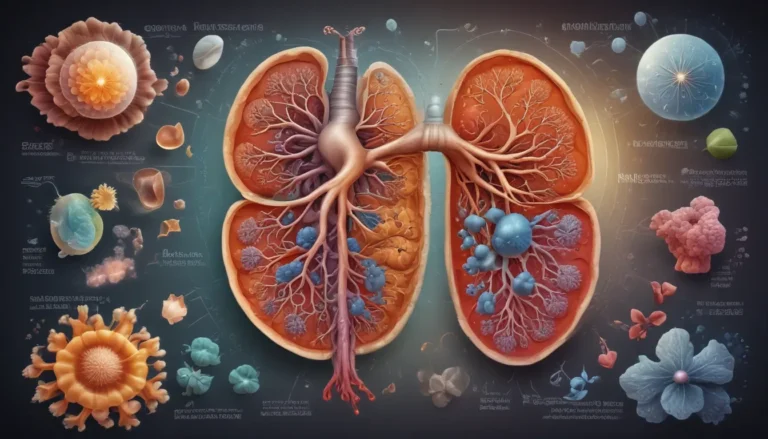A Note About Images: The images used in our articles are for illustration purposes only and may not exactly match the content. They are meant to engage readers, but the text should be relied upon for accurate information.
Enzymes are the unsung heroes of the biological world, silently driving essential chemical reactions that keep our bodies functioning smoothly. From aiding in digestion to facilitating DNA replication, enzymes play a crucial role in various biological processes. In this article, we will take a closer look at these remarkable proteins and uncover 17 astounding facts that highlight their importance and versatility. Whether you are a science enthusiast or simply curious about the mysteries of life, prepare to be amazed by the captivating world of enzymes!
The Marvels of Enzymes
- Enzymes are like superheroes: Enzymes serve as biological catalysts, speeding up chemical reactions without being consumed in the process. They have specific targets and can operate in diverse environments, making them essential for our health and well-being.
Enzymes: The Protein Powerhouses
Enzymes are protein-based molecules that act as catalysts, accelerating chemical reactions within living organisms. Their unique structure allows them to perform vital functions in the intricate web of biochemical processes that govern life.
The Precision of Enzymes
Each enzyme is designed with a specific target in mind, thanks to its unique shape and structure. This specificity ensures that enzymes only catalyze the desired reactions, enhancing efficiency and accuracy in biological processes.
The Resilience of Enzymes
Unlike other molecules involved in chemical reactions, enzymes remain unchanged after catalyzing a reaction. This characteristic enables enzymes to be reused multiple times, making them incredibly efficient and sustainable.
Temperature Tolerance of Enzymes
Enzymes have an optimal temperature range in which they function most effectively. Extreme temperatures can denature enzymes, altering their shape and rendering them ineffective. This phenomenon explains the impact of high fevers on enzymatic processes in the body.
Unveiling Enzyme Names
Enzymes are easily recognizable by their names, which typically end with the suffix “-ase.” For instance, protease breaks down proteins, while lipase targets lipids. These distinct names highlight the specific roles enzymes play in biochemical reactions.
Ubiquitous Presence of Enzymes
Enzymes can be found in every cell of living organisms, from microscopic bacteria to complex animals. Their ubiquitous presence underscores their fundamental importance in maintaining biological functions at the cellular level.
Adaptability of Enzymes
Enzymes showcase remarkable adaptability by functioning in both acidic and alkaline environments. While pH levels can influence enzyme activity, their ability to operate effectively under varying conditions makes them versatile catalysts in biological systems.
Regulation of Enzymes
Enzymes can be regulated through feedback inhibition, where the end product of a metabolic pathway inhibits the enzyme responsible for its production. This regulatory mechanism prevents the accumulation of excess substances in the body.
Industrial Applications of Enzymes
Enzymes have diverse applications in various industries, including food processing, detergent manufacturing, and biofuel production. Their efficiency and specificity make them invaluable tools in streamlining industrial processes.
Cofactors in Enzyme Function
Some enzymes require cofactors, such as metal ions or coenzymes, to function optimally. These non-protein substances assist enzymes in catalyzing reactions, enhancing their efficiency and facilitating complex biochemical processes.
Inhibition of Enzymes
Certain molecules can inhibit or block the active site of an enzyme, disrupting its catalytic activity. This inhibition can be reversible or irreversible, depending on the nature of the inhibiting molecule and its interactions with the enzyme.
Classification of Enzymes
Enzymes can be classified into different categories based on the type of reactions they catalyze. Common categories include hydrolases, which facilitate molecule breakdown through hydrolysis, and oxidoreductases, which mediate oxidation-reduction reactions.
pH Sensitivity of Enzymes
Enzymes exhibit optimal function within specific pH ranges. Extreme pH levels can denature enzymes, leading to structural changes that impair their catalytic activity. Maintaining pH balance is crucial for preserving enzyme function.
Enzymes in DNA Replication
DNA polymerase, an enzyme essential for DNA replication, ensures the accurate duplication of genetic information. By adding nucleotides to the growing DNA strand based on a template, DNA polymerase plays a critical role in preserving genetic integrity.
Vital Role of Enzymes in Digestion
Enzymes like amylase, lipase, and protease are secreted in the digestive system, breaking down carbohydrates, lipids, and proteins for nutrient absorption. Without these enzymes, the process of digestion would be compromised, affecting overall health.
Dynamic Conformational Changes in Enzymes
When enzymes bind to substrates, they can undergo conformational changes that optimize the active site for catalysis. This dynamic process enhances the efficiency and specificity of enzymatic reactions, ensuring precise control over biochemical transformations.
Precision and Specificity of Enzymatic Action
Enzymes are highly specific in their action, often catalyzing only a single type of substrate or reaction. This precision allows enzymes to orchestrate complex biochemical pathways with accuracy, contributing to the overall harmony of biological processes.
In conclusion, enzymes are indispensable players in the grand symphony of life, orchestrating essential biochemical reactions that sustain living organisms. Their versatility, specificity, and resilience make them invaluable tools in scientific research, medicine, and industrial applications. By unraveling the secrets of enzymes, we gain a deeper understanding of the building blocks of life and pave the way for innovative discoveries that can benefit humanity.
Frequently Asked Questions
-
What are enzymes?
Enzymes are protein-based molecules that act as catalysts, accelerating chemical reactions in living organisms. -
How do enzymes work?
Enzymes function by binding to specific substrates and lowering the activation energy required for a reaction to occur. -
Are enzymes reusable?
Yes, enzymes can be used repeatedly in chemical reactions, making them highly efficient and sustainable catalysts. -
Can enzymes function in extreme conditions?
Some enzymes, known as extremozymes, can operate in extreme conditions such as high temperatures or pH levels outside the norm. -
How are enzymes named?
Enzymes are typically named based on the type of reaction they catalyze, with names ending in “-ase” to indicate their catalytic function. -
What are some examples of enzymes?
Common examples of enzymes include amylase, lipase, protease, and DNA polymerase, each with a specific role in biochemical reactions. -
Can enzymes be used in industrial processes?
Yes, enzymes have diverse industrial applications, ranging from food processing to pharmaceuticals, where they serve as efficient catalysts for complex reactions. -
How are enzymes regulated in the body?
Enzymes can be regulated through various mechanisms, including feedback inhibition, gene expression, and covalent modifications, to maintain cellular homeostasis. -
Can enzymes be denatured?
Yes, enzymes can be denatured by factors like extreme temperatures or pH levels, leading to changes in their structure that impair their catalytic activity. -
What is the significance of enzymes in medicine?
Enzymes play a vital role in medicine, where they can be targeted to inhibit specific disease pathways or used to deliver therapeutic interventions with precision and efficacy.
Our commitment to delivering trustworthy and engaging content drives our mission to provide accurate and insightful information to our readers. Every fact we share is contributed by individuals like you, reflecting a diverse range of perspectives and knowledge. Through our dedicated editorial process, we ensure that each submission meets our high standards of credibility and authenticity. Trust in our dedication to quality as you explore and learn alongside us.






